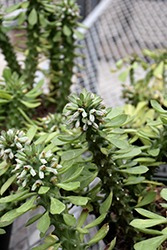It's all about ...
plants

Height: 3 feet
Spread: 24 inches
Sunlight:
![]()
Hardiness Zone: 8b
Other Names: syn. Monadenium guentheri
Description:
An attractive, unusual plant for a sunny border; long, unbranched, cylindrical stems, with prominent, spine-tipped tubercles and fleshy deciduous leaves; cream and red flowers with pale green bracts are subtle; a truly exotic garden accent plant
Ornamental Features
Sausage Spurge is a highly distinctive and unusual plant. Although it actually isn't technically a cactus, it is still a succulent evergreen which behaves much like a cactus. It is characterized by the highly modified and distinctive mottled cylindrical green stems that comprise the bulk of the plant, and which are designed to retain water for extended periods of time. Its attractive oval leaves remain light green in colour with hints of chartreuse throughout the season. This plant has masses of beautiful clusters of creamy white flowers with antique red overtones and light green bracts held atop the stems from late winter to mid spring, which are most effective when planted in groupings.
Landscape Attributes
Sausage Spurge is an unusual succulent evergreen plant with an upright spreading habit of growth. Unlike a cactus, which this plant resembles, it does have foliage, but it's the mottled green narrow cylindrical segments that are of primary interest from a landscape or garden perspective.
This is a relatively low maintenance plant, and should only be pruned after flowering to avoid removing any of the current season's flowers. Deer don't particularly care for this plant and will usually leave it alone in favor of tastier treats. Gardeners should be aware of the following characteristic(s) that may warrant special consideration;
- Spiny
Sausage Spurge is recommended for the following landscape applications;
- Mass Planting
- Rock/Alpine Gardens
- Border Edging
- General Garden Use
- Container Planting
Planting & Growing
Sausage Spurge will grow to be about 3 feet tall at maturity, with a spread of 24 inches. It grows at a medium rate, and under ideal conditions can be expected to live for approximately 8 years. As an herbaceous perennial, this plant will usually die back to the crown each winter, and will regrow from the base each spring. Be careful not to disturb the crown in late winter when it may not be readily seen!
This plant should only be grown in full sunlight. It prefers dry to average moisture levels with very well-drained soil, and will often die in standing water. This plant should not require much in the way of fertilizing once established, although it may appreciate a shot of general-purpose fertilizer from time to time early in the growing season. It is not particular as to soil pH, but grows best in sandy soils. It is highly tolerant of urban pollution and will even thrive in inner city environments. This species is not originally from North America, and parts of it are known to be toxic to humans and animals, so care should be exercised in planting it around children and pets. It can be propagated by cuttings.
Sausage Spurge is a fine choice for the garden, but it is also a good selection for planting in outdoor pots and containers. With its upright habit of growth, it is best suited for use as a 'thriller' in the 'spiller-thriller-filler' container combination; plant it near the center of the pot, surrounded by smaller plants and those that spill over the edges. It is even sizeable enough that it can be grown alone in a suitable container. Note that when growing plants in outdoor containers and baskets, they may require more frequent waterings than they would in the yard or garden. Be aware that in our climate, most plants cannot be expected to survive the winter if left in containers outdoors, and this plant is no exception. Contact our experts for more information on how to protect it over the winter months.
This plant is not reliably hardy in our region, and certain restrictions may apply; contact the store for more information.
